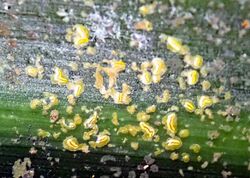Biology:Enterographa bella
| Enterographa bella | |
|---|---|

| |
| Scientific classification | |
| Domain: | Eukaryota |
| Kingdom: | Fungi |
| Division: | Ascomycota |
| Class: | Arthoniomycetes |
| Order: | Arthoniales |
| Family: | Roccellaceae |
| Genus: | Enterographa |
| Species: | E. bella
|
| Binomial name | |
| Enterographa bella R.Sant. (1952)
| |
Enterographa bella is a species of foliicolous (leaf-dwelling) lichen in the family Roccellaceae.[1] The lichen is characterised by its orange-brown, often wavy [[Glossary of lichen terms#{{biology:{1}}}|{{Biology:{1}}}]] (fruiting bodies). Its [[Glossary of lichen terms#{{biology:{1}}}|{{Biology:{1}}}]] partner is from the green algal genus Phycopeltis.[2]
Taxonomy
The lichen was formally described as a new species in 1952 by the Swedish lichenologist Rolf Santesson. The original documented specimens were collected from New Zealand, at Rangituhi / Colonial Knob in Wellington, where they were growing on leaves of Polystichum hispidum.[3]
Description
Enterographa bella is characterised by a pale greyish to translucent thallus that often forms small circular spots (typically 0.4–1 mm wide), which can merge into larger colonies. The thallus, containing a Phycopeltis photobiont and devoid of a prothallus, is quite thin and can spread up to 10 mm wide. This lichen has [[Glossary of lichen terms#{{biology:{1}}}|{{Biology:{1}}}]] apothecia, which are elongated and can be straight, curved, or even serpentine (curved and twisting), usually surrounded by a pale orange-pink margin. They are typically 0.5–1 mm long. Its spores have seven transverse septa) internal partitions), and measure 20–31 by 3.5–5.5 µm. The hymenium, which measures 55–70 µm thick, has a diffusely pale brown colour towards the upper part.[2] The major secondary metabolite (lichen product) present in Enterographa bella is psoromic acid. Chemical spot test reactions on the lichen are P+ (yellow) and C−.[4] The asexual morph of the [[Glossary of lichen terms#{{biology:{1}}}|{{Biology:{1}}}]] fungus is unknown.[5]
Similar species
The South American species Enterograph falcata has external and anatomical characteristics that are similar in appearance to E. bella. It can be distinguished by its 3-septate ascospores, compared to the 7-septate spores of E. bella.[6]
Habitat and distribution
Although Enterographa bella considered for several decades after its discovery to be endemic to New Zealand, its recorded occurrence in Victoria, Australia expanded its known distribution.[7] It was also later documented from Tasmania in 2021.[2]
References
- ↑ "Enterographa bella R. Sant.". Species 2000: Naturalis, Leiden, the Netherlands. https://www.catalogueoflife.org/data/taxon/39Y5L.
- ↑ 2.0 2.1 2.2 Kantvilas, Gintaras (2021). "The lichen genus Enterographa Fée (Roccellaceae) in Tasmania". Muelleria 40: 31–38. https://www.researchgate.net/publication/355094530.
- ↑ Santesson, R. (1952). Foliicolous Lichens: A Revision of the Taxonomy of the Obligately Foliicolous, Lichenized Fungi, Volume 1. Symbolae Botanicae Upsalienses. 12. Uppsala: Lundequistska bokhandeln. p. 106.
- ↑ Aptroot, André; Sipman, Harrie J. M.; Spier, J.Leo (2003). "Diagnostic chemistry of foliicolous Enterographa". The Bryologist 106 (2): 278–279. doi:10.1639/0007-2745(2003)106[0278:DCOFE2.0.CO;2].
- ↑ Zeng, Xiang-Yu; Wu, Hai-Xia; Hongsanan, Sinang; Jeewon, Rajesh; Wen, Ting-Chi; Maharachchikumbura, Sajeewa S.N.; Chomnunti, Putarak; Hyde, Kevin D. (2019). "Taxonomy and the evolutionary history of Micropeltidaceae". Fungal Diversity 97 (1): 393–436. doi:10.1007/s13225-019-00431-8.
- ↑ Lücking, R.; Wirth, V.; Ferraro, L.I.; Cáceres, M.E.S. (2003). "Foliicolous lichens from Valdivian temperate rain forest of Chile and Argentina: evidence of an austral element, with the description of seven new taxa". Global Ecology and Biogeography 12 (1): 21–36. doi:10.1046/j.1466-822X.2003.00319.x.
- ↑ Ralston, Kathleen (1999). "Additional lichen records from Australia 38. Enterographa bella R. Sant.". Australasian Lichenology 44: 6. https://www.anbg.gov.au/abrs/lichenlist/AL_44.pdf.
Wikidata ☰ Q10484501 entry
 |

